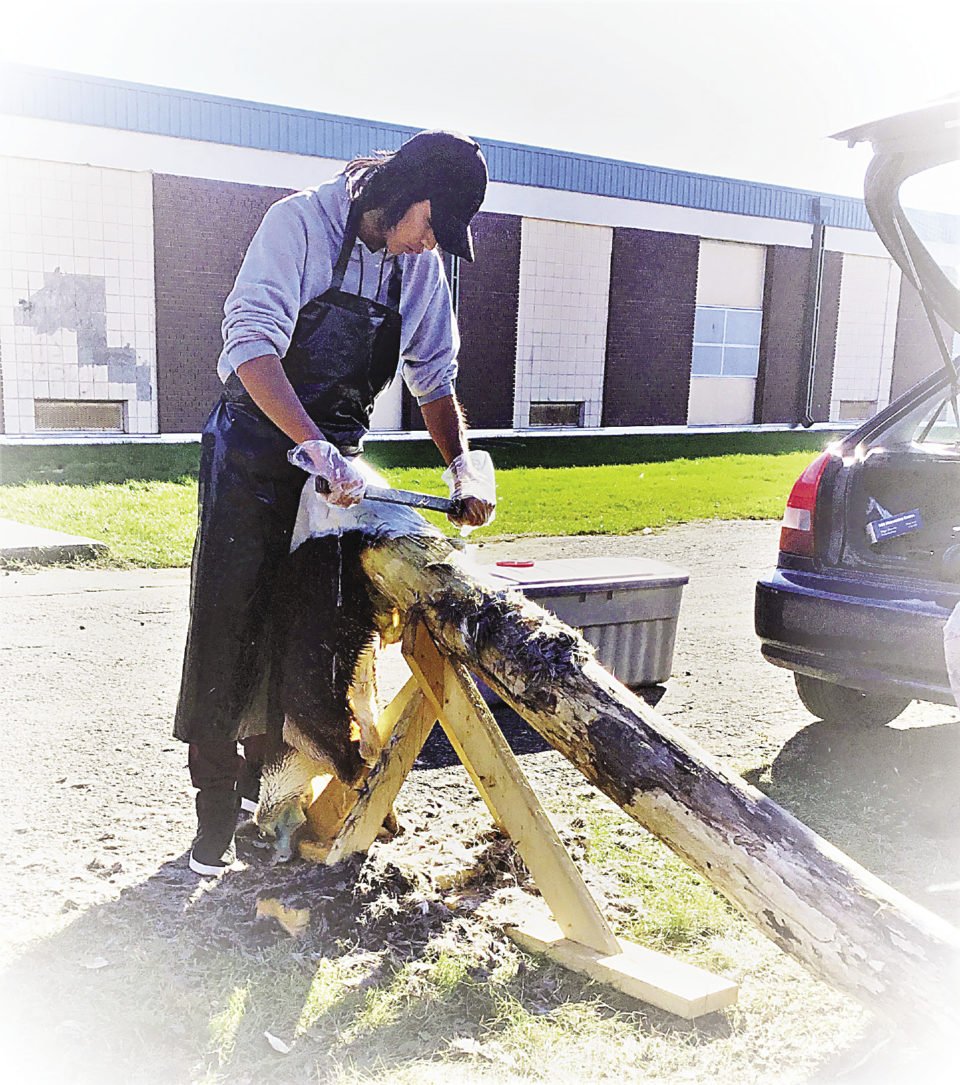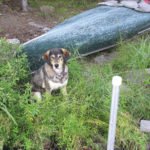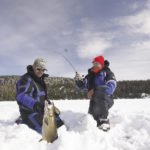Garrick Waswa is a soft-spoken 16-year-old who grew up in Eabametoong First Nation. The remote fly-in community, also known as Fort Hope, is situated on the north shore of Eabamet Lake, about 225 miles north of Thunder Bay, Ontario.
I met Garrick with his classmates at Hammarskjold High School in Thunder Bay this past fall, as part of a new program that incorporates traditional knowledge and teachings into the academic curriculum for First Nation, Métis and Inuit students.
It was a cool October afternoon, and Chris Larocque, the Ojibway language class teacher, had brought two deer hides that were donated by a student’s father. Our task that day was to learn how to remove any excess fat and flesh in preparation for traditional tanning to make buckskin, which would later be sewn into crafts by the students.
I began with a demonstration of how to hold the hide over the fleshing beam and position the blade of the scraper, working in calculated strokes. But in a crowd of more than 40 people, it was hard to tell whether everyone could see or understand what I was doing. Keen to get started, a few students put on aprons and we went to work.
It usually takes a bit of time to develop a feel for scraping a hide: to get a sense of the pressure and angle of the blade; how to work efficiently. Some students initially approached it with caution, seeming unsure of what they were getting into.
But when it was Garrick’s turn, he picked up the scraping tool and held it comfortably in his hands. He handled the hide with ease and confidence. He worked rhythmically, and soon his friends crowded around him, watching.
Melissa Roberts, the teacher who heads the Indigenous Cultural Academy, otherwise known as Kendomang Zhagodenamonon Lodge, noticed him, too.
“Have you ever done anything like this before back home?” she asked him later, taking him aside.
“No,” replied Garrick. “I’ve never tried it in my life.” He was excited, shuffling his feet, and smiling with pride.
“That’s blood memory,” Roberts said. “That’s your ancestors working through you.”
Blood memory describes the ancestral, or genetic, connection to a people’s language, songs, spirituality and teachings. Certain skills or traits, which were never learned in that person’s lifetime, are passed down.
“Garrick’s aptitude for tanning hides is a result of his blood memory. Our ancestors’ knowledge is passed on through our DNA so that even if we have never done something before, we feel like we have,” said Roberts. “We may ‘know’ songs that we have never heard before, we may feel like we know an area of land even though we may never have been there before—all because our ancestors sang and were on that land. Because everything in the world has a spirit, our ancestors live in the rocks and trees and in the water. So they are always around us, sharing their teachings with us.”
I later sat down with him to talk about his experience. When I asked if tanning a deer hide felt familiar to him, he nodded.
“Yes, very familiar,” he said. “I felt a connection there. I didn’t know what I was about to do, but I wanted to give it a try. I got into it and I don’t know, it was a weird feeling. I felt like I knew what I was doing from the first scrape.”
By Western academics, the curiosity of genetic memory, or blood memory, has been written about since the 20th century, perhaps even earlier. Carl Jung used the term “collective unconscious” to define his even broader concept of inherited traits and collective wisdom shared among creatures of the same species.
Back at Kendomang Zhagodenamonon Lodge, the program helps students reach their potential through the teachings of their ancestors—to tap into that bank of genetic memory and culture.
“The program was given its name by a local elder, and it means, the more knowledge we have of the Seven Grandfather Teachings, which are the guiding principles of Anishinaabe life, the more success we will have at overcoming our challenges and our fears in life,” said Roberts, who runs the program alongside Tanya Moses from the Indigenous Friendship Centre.
“It’s a program for students to help them build their self-esteem, their self-confidence, and in order to help them do that, we focus on the land, the language, their communities and their culture. So every subject that we [learn] has some cultural component.”
For a project like tanning a deer hide, Roberts’ job is to tie that experience back into the curriculum for high school credits.
“So for all the team work that we’ve been doing together on the deer hide that counts toward life skills. I’ll get them to write down the process that we went through to tan the hides, which counts towards English…In science, we can talk about what they eat, and their predators. Geography: we can talk about where the deer populations are, how climate change impacts deer populations…What’s their food source? All of those things,” she said.
“What’s awesome is that these kids haven’t got a clue that what they’re doing is giving them credit…they’ll likely be surprised and say, well I was just tanning a deer hide.”
Although the class is moving on to different projects, the hide tanning program is proving to be memorable.
We happened to be softening a deer hide in the classroom while members of the school’s Indigenous student Fire Council were holding a meeting. As they discussed an upcoming screening of Indian Horse, the students and teachers took turns working on the hide, which had been soaking in brains the day before. It smelled less than floral, according to staff down the hallway. But one girl, who’s also from Fort Hope, found it to bring a sense of comfort and familiarity.
“It’s a good smell,” she said. “It smells like home.”




